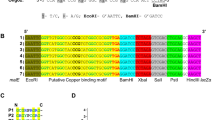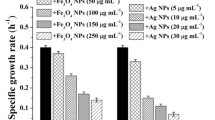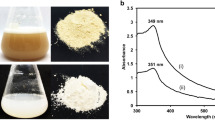Abstract
The properties of Escherichia coli cells, acquired by cell surface presentation of one or two hexa-histidine (His) clusters carried by the outer membrane LamB protein, have been examined. Strains producing LamB hybrids with the His chains accumulated greater than 11-fold more Cd2+ than E. coli cells expressing the protein without the His insert. Furthermore, the hexa-His chains on the cell surface caused cells to adhere reversibly to a Ni2+-containing solid matrix in a metal-dependent fashion. Thus, expression of poly-His peptides enables bacteria to act as a metalloaffinity adsorbent. These results open up the possibility for biosorption of heavy ions using engineered microorganisms.
This is a preview of subscription content, access via your institution
Access options
Subscribe to this journal
Receive 12 print issues and online access
$209.00 per year
only $17.42 per issue
Buy this article
- Purchase on Springer Link
- Instant access to full article PDF
Prices may be subject to local taxes which are calculated during checkout
Similar content being viewed by others

References
Nriagu, J.O. and Pacyna, J.M. 1989. Quantitative assessment of worldwide contamination of air, water and soils by trace metals. Nature 333: 134–139.
Beveridge, T.J. 1989. Metal ions and bacteria, pp. 21–29 in Metal ions and bacteria. Beveridge, T.J. and Doyle, R.J. (eds.). Willey and Sons, New York.
Gadd, G.M. and White, C. 1993. Microbial treatment of metal pollution—a working biotecnology? Trends Biotech. 11: 353–359.
Ji, G. and Silver, S. 1995. Bacterial resistance mechanisms for heavy metals of environmetal concern. J. Ind. Microbiol. 14: 61–75.
Torma, A.E. 1988. Leaching of metals, pp. 367–399 in Biotechnology vol. 6b: Special microbial processes. Rehm, H.J. (ed.). VCH Weinheim, Germany.
Lovely, D.R., Phillips, E.J.P., Gorby, Y.A. and Landa, E.R. 1991. Microbial reduction of uranium. Nature 350: 413–416.
Butt, T.R. and Ecker, D.J. 1987. Yeast metallothionein and applications in biotechnology. Microbiol. Rev. 51: 351–364.
Murooka, Y. and Nagaoka, T. 1987. Expression of cloned monkey metallothionein in Escherichia coli . Appl. Environ. Microbiol. 53: 204–207.
Jacobs, F.A., Romeyer, P.M., Beaucheim, M., and Brousseau, R. 1989. Human metallothionein-II is synthesized as a stable membrane-localized fusion protein in Escherichia coli . Gene 83: 95–103.
Laib, J.E., Shaw, C.F., Petering, D.H., Eidsness, M.K., Elder, R.C. and Garvey, J.S. 1985. Formation and characterization of aurothioneins: Au, Zn, Cd-thionein and (thimalato-Au)-thionein. Biochemistry 24: 1977–1986.
Hutchins, S.R., Davidson, M.S., Brierley, J.A. and Brierly, C.L. 1986. Microorganisms in reclamation of metals. Ann. Rev. Microbiol. 40: 311–336.
Hofnung, M. 1991. Expression of foreign polypeptides at the Escherichia coli cell surface. Methods Cell Biol. 4: 77–105.
Geourgiou, G., Poetschke, H., Stathopoulos, C. and Francisco, J.A. 1993. Practical applications of engineering Gram-negative bacterial cell surfaces. Trends Biotech. 11: 6–10.
Francisco, J.A., Campbell, R., Iverson, B.L. and Georgiou, G. 1993. Production and fluorescence-activated cell sorting of Escherichia coli expressing a functional antibody fragment on the external surface. Proc. Natl. Acad. Sci. USA 90: 10444–10448.
Fuchs, P., Breitling, F., Dübel, S., Seehaus, T. and Little, M. 1991. Targeting recombinant antibodies to the surface of Eschericha coli: Fusion to a peptidoglycan associated lipoprotein. Bio/Technology 9: 1369–1372.
Little, M., Fuchs, P., Breitling, F. and Dübel, S. 1993. Bacterial surface presentation of proteins and peptides: an alternative to phage technology. Trends Biotech. 11: 3–5.
Hofnung, M. 1995. An intelligent channel (and more). Science 267: 473–474.
Boulain, J.-C., Charbit, A. and Hofnung, M. 1986. Mutagenesis by random linker insertion into lamB gene of E. coli K-12. Mol. Gen. Genet. 205: 339–348.
Charbit, A., Ronco, J., Michel, V., Werts, C. and Hofnung, M. 1991. Permissive sites and topology of an outer membrane protein with a reporter epitope. J. Bacteriol. 173: 262–275.
Hochuli, E., Döbeli, H. and Schacher, A. 1987. New metal chelate adsorbents selective for proteins and peptide containing neighbouring histidine residues. J. Chromatography 411: 177–184.
Qiagen Inc. 1992. Qiaexpress, the high level expression and protein purification system. Qiagen Inc., Chatsworth, California.
Kemper, M.A., Urrutia, M.M., Beveridge, T.J., Koch, A.L. and Doyle, R.J. 1993. Proton motive force may regulate cell wall-associated enzymes of Bacillus subtillis . J. Bacteriol. 175: 5690–5696.
Krämer, U., Cotter-Howells, J.D., Charnock, J.M., Bakers, A.J.M. and Smith, J.A. 1996. Free histidine as a metal chelator in plants that accumulate nickel. Nature 379: 635–638.
Brown, S. 1992. Engineered iron oxide-adhesion mutants of the Escherichia coli phage λ receptor. Proc. Natl. Acad. Sci. USA 89: 8651–8655.
Su, G.-F., Brahmbhatt, H., Wehland, J., Rohde, M. and Timmis, K. 1992. Construction of stable LamB-shiga toxin B subunit hybrids: analysis of the expression in Salmonella typhimurium aroA strains and stimulation of B subunit-specific mucosal and serum antibody responses. Infect. Immun. 60: 3345–3359.
Cebolla, A., Guzmán, C. and de Lorenzo, V. 1996. Nondisruptive detection of activity of catabolic promoters of Pseudomonas putida with an antigenic surface reporter system. Appl. Environ. Microbiol. 62: 214–220.
Miller, J.H. 1972. pp. 201–205 in Experiments in molecular genetics. Cold Spring Harbor Laboratory Press, Cold Spring Harbor, New York.
Sambrook, J., Frisch, E.F. and Maniatis, T. 1989. Molecular cloning: a laboratory manual, 2nd ed. Cold Spring Harbor Laboratory Press, Cold Spring Harbor, New York.
Läemmli, U.K. 1970. Cleavage of structural proteins during the assembly of head of the bacteriophage T4. Nature 277: 680–685.
Towbin, H., Staehelin, T. and Gordon, J. 1979. Electrophoretic transfer of proteins from polyacrilamide gels to nitrocellulose sheets: procedure and some applications. Proc. Natl. Acad. Sci. USA 76: 4350–4354.
Romeyer, F.M., Jacobs, F.A., Masson, L., Hanna, Z., and Brousseau, R. 1988. Bioaccumulation of heavy metals in Escherichia coli expressing an inducible synthetic human metallothionein gene. J. Biotechnol. 8: 207–220.
Janknecht, R., de Martynoff, G., Lou, J., Hipskind, R.A., Nordheim, A., and Stunnenberg, H.G. 1991. Rapid and efficient purification of native histidine tagged protein expressed by recombinant vaccinia virus. Proc. Natl. Acad. USA 88: 8972–8976.
Author information
Authors and Affiliations
Rights and permissions
About this article
Cite this article
Sousa, C., Cebolla, A. & de Lorenzo, V. Enhanced metalloadsorption of bacterial cells displaying poly-His peptides. Nat Biotechnol 14, 1017–1020 (1996). https://doi.org/10.1038/nbt0896-1017
Received:
Accepted:
Issue Date:
DOI: https://doi.org/10.1038/nbt0896-1017
This article is cited by
-
Recent advances in bacterial biosensing and bioremediation of cadmium pollution: a mini-review
World Journal of Microbiology and Biotechnology (2022)
-
Removal of Ni2+ and Cd2+ by Surface Display of Polyhistidine on Bacillus subtilis Spore Using CotE Anchor Protein
Biotechnology and Bioprocess Engineering (2019)
-
Surface display of PbrR on Escherichia coli and evaluation of the bioavailability of lead associated with engineered cells in mice
Scientific Reports (2018)
-
Surface display of metal binding domain derived from PbrR on Escherichia coli specifically increases lead(II) adsorption
Biotechnology Letters (2018)
-
Surface display of lipolytic enzyme, Lipase A and Lipase B of Bacillus subtilis on the Bacillus subtilis spore
Biotechnology and Bioprocess Engineering (2017)


